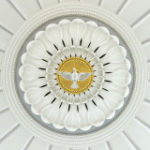In this year of the Great Jubilee of the Coming of the Redeemer, the dialogue between East and West has a special urgency for those who believe in Jesus Christ and see in the Church he founded an extension of himself in time and space.
I count it a genuine honor to be invited to reflect with you on the recent history of the dialogue between the Orthodox Church and the Catholic Church, between the East with its memories of the splendor of Byzantium and the West with its recollections of the glory that was Rome. This reflection we make in the light of a history rooted in a thousand years and more of shared history and acknowledged unity in the One Church of Christ. It takes place at the University of Scranton, where the Center for Eastern Christian Studies and the periodical Diakonia render distinguished service to the faith, traditions, practices and art of the Christian East.
As I prepared for today, I reread the public statements and correspondence between the Ecumenical Patriarchate and the Holy See during the earlier years of our ecumenical pilgrimage. (Towards the Healing of Schism, E. J. Stormon, S.J., editor, Paulist Press, 1987) The statements begin with the final illness and then death of Pope Pius XII and the expressions of sympathy on the part of Ecumenical Patriarch Athenagoras, offered to the world through press statements.
With the election of Angelo Roncalli as Pope John XXIII, the statements became both frequent and heartfelt. In his first Christmas message, the new Bishop of Rome recalled an Orthodox initiative for greater visible unity in the Christian family and regretted it could not be fully implemented. Almost immediately, Patriarch Athenagoras, who had been personally involved in the effort of the early 1920’s and who had worked for greater understanding among Christians during his many years in the United States, responded positively. With the election of Pope Paul VI in 1963, the relationship continued. When the first direct contacts between the new pope and Patriarch Athenagoras took place by letter, the official newspaper of the Ecumenical Patriarchate spoke of new relations between “sister churches,” anticipating language to be adopted in due course by the Churches themselves.
By January 1964 the statements could give way to deeds. On the Mount of Olives near Jerusalem Pope and Patriarch, Peter and Andrew, could embrace and begin what they called “the dialogue of charity.” This was beautifully symbolized by the icon Patriarch Athenagoras later gave to the Pope as a remembrance of their meeting. It shows the two brother-apostles, Peter and Andrew, the patrons of Rome and Constantinople respectively, in fraternal embrace. That icon is now in the conference room of the Pontifical Council for Promoting Christian Unity in Rome, a permanent reminder of the new relationship that was being forged between Catholics and Orthodox, and of the hope for full unity it continues to inspire. In the days following the Jerusalem meetings at the Catholic Apostolic Delegation and the Greek Orthodox Patriarchate Summer Palace the messages between Pope Paul VI and Patriarch Athenagoras grew in frequency, warmth and evident mutual respect.
The Pope showed great interest in the Orthodox plans for a great and holy Synod and sent messages of good wishes when the preparatory committee met. The Patriarch, for his part, gave full official status to his representative to the Second Vatican Council and provided for a delegation of three observers to the Council. One of the three during the final phase of the Council is today Metropolitan Maximos, the Presiding Hierarch of the Diocese of Pittsburgh, who is co-chair of both the Theological Consultation between our Churches in North America and of the Bishops’ Committee. (Cf. Telegram from Patriarch Athenagoras to Cardinal Bea, October 24, 1964, Op. cit., p. 85) Archbishop Rembert Weakland of Milwaukee is the co-c

